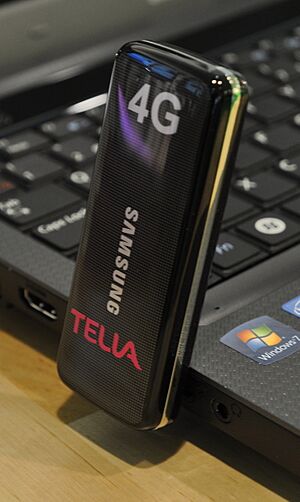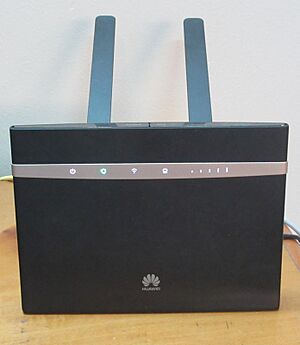4G facts for kids
4G is the fourth generation of cellular network technology. It started appearing in the late 2000s and early 2010s. Think of it as a big upgrade from 3G (third generation) technology.
4G was designed to handle all kinds of internet traffic, like fast internet for your phone or tablet. It also changed how phone calls work, moving them to the internet instead of older methods. A huge benefit of 4G is its much faster internet speed compared to 3G. This allows you to do things like watch high-definition videos online easily and helps connect more smart devices (IoT) to the internet.
The first technologies called "4G" were Long Term Evolution (LTE) and Mobile Worldwide Interoperability for Microwave Access (Mobile WiMAX). These technologies brought big improvements over 3G and 2G networks.
Contents
What is 4G Speed?
In 2008, a group called the International Telecommunication Union-Radio communications sector (ITU-R) set some goals for 4G speeds. They said 4G should be able to reach:
- 100 megabits per second (Mbit/s) when you are moving fast, like in a train or car.
- 1 gigabit per second (Gbit/s) when you are not moving, like walking or sitting still.
Early versions of LTE and WiMAX didn't quite reach these super-fast speeds, but they were still much faster than 3G. Because they were a big step forward, the ITU-R decided these technologies could still be called "4G." Later, improved versions like LTE Advanced (LTE-A) and Mobile WiMAX Release 2 were developed, which could reach speeds closer to 1 Gbit/s. These are sometimes called "true 4G" or "4G+."
Unlike older phone networks, 4G systems don't use the traditional way of making phone calls. Instead, they use Internet Protocol (IP), which is how data travels on the internet. This means phone calls on 4G are like internet calls.
How Mobile Generations Work
In mobile communication, a "generation" usually means a big change in how the service works. This includes new ways of sending data, faster speeds, and the ability to handle more users at once.
New mobile generations have appeared about every ten years:
- 1G (around 1981): First analog mobile phones.
- 2G (around 1992): Digital mobile phones.
- 3G (around 2001): Added multimedia support and faster data (at least 200 kbit/s).
- 4G (around 2011/2012): All-internet-based networks with very fast mobile internet (gigabit speeds).
Groups like IEEE, WiMAX Forum, and 3GPP do the actual work of creating these standards.
What 4G Needs to Do
For a mobile system to be considered "4G" by the ITU-R (under their IMT-Advanced rules), it needs to meet certain requirements:
- It must be based entirely on an internet-based network.
- It should have peak data speeds of about 100 Mbit/s for mobile use and up to 1 Gbit/s for stationary use.
- It needs to share network resources efficiently to support many users at the same time.
- It should use flexible channel sizes, usually between 5 and 20 MHz, and sometimes up to 40 MHz.
- It must allow smooth transitions (handover) between different types of networks.
The main technologies that aimed to meet these requirements were LTE Advanced (from 3GPP) and 802.16m (from IEEE).
Some mobile companies advertised their services as "4G" even if they didn't fully meet the highest speed goals. These were often called "3.9G" or "pre-4G." However, the ITU-R later said these could also be called "4G" if they showed a big improvement over 3G. For example, Vodafone Netherlands called LTE "4G" and LTE Advanced "4G+."
Types of 4G Systems
LTE Advanced
LTE Advanced is an improved version of LTE. It was designed to meet and even go beyond the ITU's requirements for 4G. It's not a completely new technology but an upgrade to the existing LTE network. This makes it easier and cheaper for companies to upgrade their networks. LTE Advanced uses more radio frequencies and smart ways to send data to achieve higher speeds.
| LTE Advanced | |
|---|---|
| Peak download | 1000 Mbit/s |
| Peak upload | 500 Mbit/s |
IEEE 802.16m (WirelessMAN-Advanced)
The IEEE 802.16m standard, also known as WirelessMAN-Advanced or WiMAX 2, was developed to meet the 4G goals of 1 Gbit/s for stationary users and 100 Mbit/s for mobile users.
Early 4G Versions
Long Term Evolution (LTE)

The first version of 3GPP Long Term Evolution (LTE) is often called "4G – LTE." While it didn't fully meet the highest 4G speed goals, it was still very fast. LTE can theoretically reach speeds of up to 100 Mbit/s for downloading and 50 Mbit/s for uploading, especially when using multiple-input multiple-output (MIMO) technology, which means using multiple antennas.
The world's first public LTE service started in Stockholm and Oslo on December 14, 2009. Companies like TeliaSonera launched these networks and called them "4G." Since then, LTE has spread worldwide, with many mobile carriers offering it.
| LTE | |
|---|---|
| Peak download | 150 Mbit/s |
| Peak upload | 50 Mbit/s |
Mobile WiMAX (IEEE 802.16e)
The Mobile WiMAX standard (IEEE 802.16e-2005), also known as WiBro in South Korea, was also sometimes called 4G. It offered peak data speeds of 128 Mbit/s for downloading and 56 Mbit/s for uploading.
The first commercial Mobile WiMAX service was launched in Seoul, South Korea, in June 2006. Companies like Sprint in the US and Scartel (Yota) in Russia also used Mobile WiMAX and branded it as "4G."
| WiMAX | |
|---|---|
| Peak download | 128 Mbit/s |
| Peak upload | 56 Mbit/s |
The latest version of WiMAX, WiMAX 2.1, has been updated to work with LTE-TDD systems, essentially bringing the two standards closer together.
How 4G Works (Key Technologies)
All 4G technologies share some important features:
- MIMO (Multiple-Input Multiple-Output): This means using multiple antennas at both the sender and receiver to send and receive more data at once, making the network much faster.
- OFDM (Orthogonal Frequency-Division Multiplexing): This is a way to send data using many different radio frequencies at the same time, which helps handle echoes and makes the signal stronger.
- IP-based communication: 4G networks are built entirely on Internet Protocol (IP), which is the same system the internet uses. This means all data, including voice calls, travels as internet packets.
- IPv6 Support: Since there are so many devices connecting to the internet, 4G networks support IPv6. This provides a huge number of unique internet addresses, so every device can have its own address without running out.
History of 4G
- 1991: The idea of wideband orthogonal frequency-division multiplexing (WOFDM), a key technology for 4G, was invented.
- 2002: The vision for 4G, called IMT Advanced, was created by the ITU.
- 2004: LTE was first suggested by NTT DoCoMo in Japan.
- 2006: The first commercial mobile WiMAX service started in South Korea.
- 2007: NTT DoCoMo tested a 4G system prototype that reached very high speeds.
- 2008: The ITU-R set the detailed performance goals for IMT-Advanced.
- 2009: The first commercial LTE network was launched in Stockholm and Oslo by TeliaSonera.
- 2010: The ITU officially stated that LTE, WiMAX, and similar "evolved 3G technologies" could be considered "4G."
- 2011: The first LTE smartphones became commercially available.
Challenges of 4G
One challenge with 4G, especially for voice calls (VoLTE), is that if you travel internationally or switch phone companies, your phone might need specific settings to make 4G calls on a different network. Even if the frequency band matches, the phone might need a software update from the local carrier. However, if 4G voice calls don't work, your phone can usually still make calls using older 2G or 3G networks if they are available.
Beyond 4G: The Future
As of 2025, many countries are moving from 4G to 5G, which is the next generation of mobile technology. 5G promises even faster speeds, almost no delay (lower latency), and the ability to connect a massive number of devices at the same time.
4G networks are expected to continue working alongside 5G networks for many years. They will provide coverage in places where 5G isn't available yet.
Past 4G Networks
Some 4G networks have been shut down as technology evolves or companies change their services. Here are a few examples:
| Country | Network | Shutdown date | Standard | Notes |
|---|---|---|---|---|
| Xplore Mobile | 2022-08-31 | LTE | ||
| Digicel | 2018-10-31 | WiMAX | ||
| Smartone | 2024-11-11 | LTE | Smartone stopped operating in Macau and gave back its license to the government. | |
| Yes 4G | 2019-10-01 | WiMAX | ||
| Nepal Telecom | 2021-12-31 | WiMAX | ||
| Blink bmobile (TSTT) | 2015-03-03 | WiMAX | ||
| Sprint | 2016-03-31 | WiMAX | ||
| T-Mobile (Sprint) | 2022-06-30 | LTE |
See also
 In Spanish: 4G para niños
In Spanish: 4G para niños
- 1G
- 2G
- 3G
- 5G
- 6G
- 4G-LTE filter
- Comparison of mobile phone standards
- Comparison of wireless data standards
- Wireless device radiation and health


